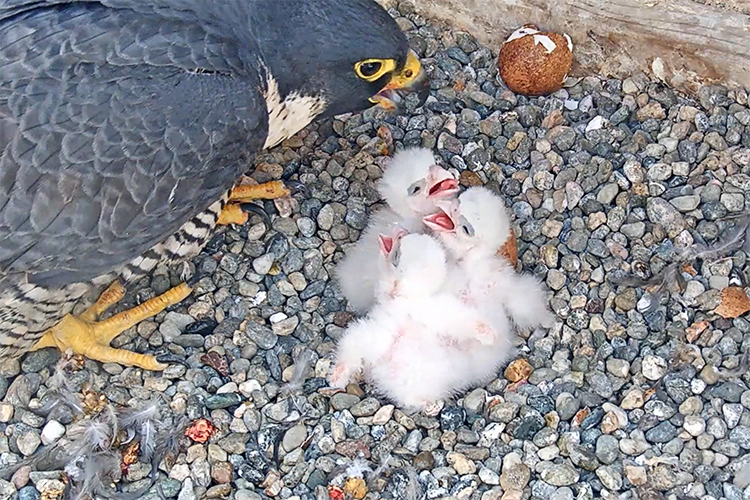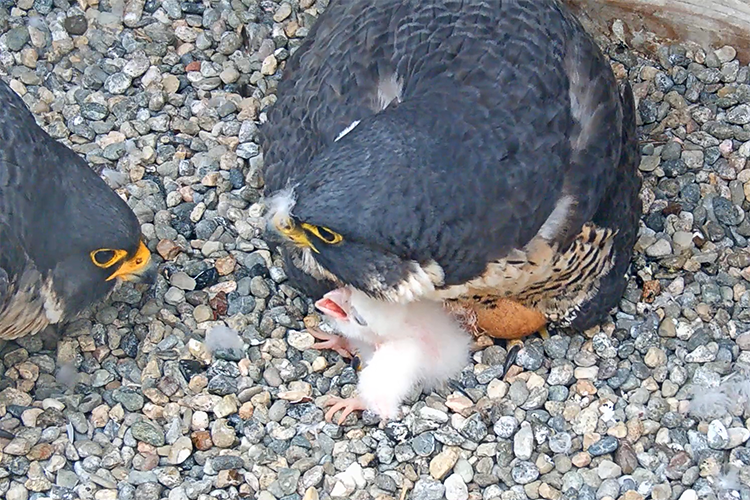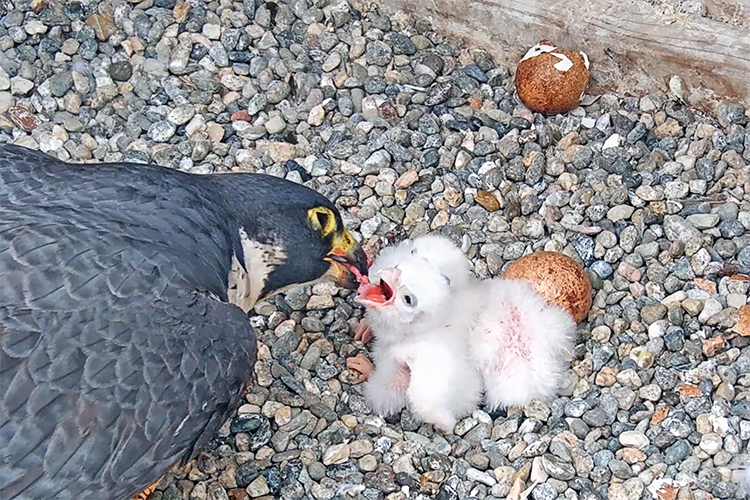Healthy triplet peregrine falcons hatch on the Campanile
'Annie and Grinnell have been tremendously successful as a breeding pair,' says local ornithologist
April 19, 2021

Annie with her three chicks. Two were born Saturday, April 17, and one on Monday, April 19. (Cal Falcons image)
Three new peregrine falcons — fluffy, energetic and already eating meat — are now part of the campus community. Two hatchlings arrived Saturday — at around 3 a.m. and 12 noon — and the other this morning just before 6. Hundreds of people have been viewing the nest activity via a Campanile webcam, and about 1,800 showed up for the livestreamed Hatch Day Q&A session held Saturday afternoon by Cal Falcons.
Falcon mother Annie laid four eggs in March, but one of them hasn’t hatched and, since it shows no cracks, “the possibilities are dimming that it will,” said Mary Malec, a Cal Falcons member who monitors local raptor nests for the East Bay Regional Park District. “It’s still a possibility, but the possibility isn’t good.”
Malec said she believes the third egg to hatch was the last one laid.
Still, the new chicks are the 11th, 12th and 13th for mates Annie and Grinnell. This is the adults’ fifth breeding season on the bell tower, and the second year in a row that they’ve welcomed triplets — last year’s chicks were Poppy, Sequoia and Redwood.
“We’re super-excited that we’ve had a successful hatch; it’s always a little nerve-wracking, leading up to that moment, as so many things can go wrong,” said Sean Peterson, a Berkeley graduate student in the Department of Environmental Science, Policy and Management who runs Cal Falcons with ornithologist Lynn Schofield, his wife. “Annie and Grinnell have done such an amazing job: Thirteen chicks hatched in five years is a great accomplishment.”
Added Schofield, “Annie and Grinnell have been tremendously successful as a breeding pair.”

Watchful Annie’s shadow can be seen behind the two chicks born Saturday. (Cal Falcons image)
The gender of the chicks will be determined when they’re banded in mid-May, said Malec. A Cal Falcons contest for the public to name the chicks will follow.
Right now, Annie is being a “smother,” keeping her body nearly constantly on the chicks and the remaining egg unless she takes a break to eat prey brought in by Grinnell, said Malec.
Grinnell took Annie’s place on the nest briefly this morning and also took turns with her to feed the chicks, which are able to be fed tiny bits of meat. They’ll be capable of digesting bones and feathers in a few weeks, she said.
At the Cal Falcons Q & A and “watch party” on Saturday, attendees, including very young children, posed questions to Peterson, Schofield and Malec while simultaneously watching live hatching activity. Questions included why Annie eats the remains of her chicks’ hatched eggs, whether the parents’ talons could harm their young, when the chicks will fly, if the falcons drink water, and if they’re bothered by the sounds of Berkeley’s carillon bells.
Yes, after their eggs hatch, falcons often do eat the shells and remaining membranes, as it replaces the calcium their bodies have used to create shell material, said Malec. As for the parents’ sharp talons, she added, they curl them and slide their feet around their hatchlings when keeping them warm, so the risk of the chicks being cut is low. And the birds don’t seem to mind the bells.
She also answered why the falcon parents are eating small stones from the nest, saying that all raptors have a “gizzard” that aids in digestion. The rocks help the birds grind food down, as they have no teeth.

On Monday morning, Grinnell, left, takes a look at the third chick, who is still partially in its shell. (Cal Falcons image)
As for flying, said Malec, the hatchlings will become fledglings later this spring, with males, which weigh less than females, trying to fly within 39 to 40 days and females within 42 to 43 days.
Falcons, being carnivorous, don’t need to drink water, said Schofield, as they get enough water from the meat they consume. The campus has an abundance of pigeons, but “peregrine falcons are known to catch a range of birds,” added Malec.
Some inquiries led to answers that were less pleasant for some to hear. Eggs that don’t hatch and have cracks in them are often consumed by the parents, and that sometimes includes the contents, as well as the shells. “But if they’re rotten,” Malec said, “falcons tend not to eat rotten food” and might carry the eggs and shells out of the nest.
As for whether Annie and Grinnell will always stay together — each is about 7 years old — and keep reproducing on the tower their entire lives, the experts were doubtful.
“If a new individual comes along and is able to chase one or the other away, it will mate with the remaining bird instead,” said Schofield. “Annie or Grinnell could be replaced by another bird,” especially if a breeding territory saturation point is reached in the Bay Area.

Annie feeds her three chicks fresh meat from prey caught by Grinnell. The egg that hasn’t hatched is resting against the chicks. (Cal Falcons image)
In an interview, Malec said the campus community and the public have gotten attached to Annie and Grinnell, as if they were people, but falcons have the imperative to survive and reproduce, and “if something happens to one, the other is very, very likely to take on another mate, and sometimes that happens within days.
“There are floaters out there‚ some people call them interlopers. They’re adults nearby who are waiting for an opportunity to become a breeding bird. At another site I’m familiar with, I’ve seen as many as six floaters, male and female, come by in a year. They aren’t always challenging a nesting pair, and they’re often escorted away.”
In San Francisco, she said, on the PG&E building, where four eggs just hatched, falcons — who live in the wild an average of 10 to 12 years — have raised young since the early 2000s, but not the same pair of birds.
At that building, Malec said, “we started out with George and Gracie, and everyone loved George and Gracie, and we lost them both. A very, very fierce female on the eastern span of the Bay Bridge came in, and there were days of fierce battles. George disappeared first, and Gracie we only saw once after that. The other female moved in with her mate.”
“Everybody who’s ever followed raptors know it’s going to happen, and it’s part of why, when we answer questions from the public, we need to say that, at some point, Annie and Grinnell will be replaced,” said Malec. “And it’s a good thing there are floaters out there. It’s a good sign of the health of the peregrine population.”
That peregrine population should be growing by three this June, said Peterson, when this year’s chicks take their first flights and leave to look for territories of their own.